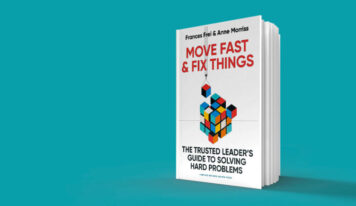Central Ideas:
- A company with a high talent density is a place where everyone wants to work. High-performing people thrive in environments where the overall talent density is higher.
- With sincerity, high-performing employees become excellent. Giving sincere feedback frequently exponentially increases the speed and efficiency of your team or workforce.
- For all creative jobs, it is best to reward an amazing employee with one of the best salaries in the market, rather than using the same money to hire a dozen or more average employees.
- When you realize you need to fire someone, instead of putting them on a performance improvement plan, use that money to give them a generous severance.
- Leading with context is harder than direct control, but it gives employees much more freedom. You provide them with as much information as possible so that your team members make great decisions without supervision or control of their actions.
About the authors:
Reed Hastings is an entrepreneur and philanthropist. He has served on the management committee of educational organizations such as Dreambox Learning. In 1997, he founded Netflix, of which he is CEO and chairman.
Erin Meyer is the author of The Culture Map and a professor at INSEAD, a prestigious business school. She is a contributor to Netflix’s organizational culture department.
Introduction
It’s not just the stock market that loves Netflix. Consumers and critics love it too. Netflix original shows like Orange Is the New Black and The Crown have become some of the most beloved of the decade, and Stranger Things is probably the most-watched television series worldwide. Shows like Elite in Spain, Dark in Germany, The protector in Turkey, and Sacred Games in India have raised the bar for fictional storytelling in their home countries and produced a new generation of global stars.
In the United States in recent years, Netflix has received more than three hundred Emmy nominations and swept several Academy Awards. In addition, Netflix has been nominated in seventeen Golden Globe categories, more than any network or streaming service, and in 2019 it has earned the top spot among the most highly regarded companies in the U.S. in the Reputation Institute’s annual National Rankings.
What has made Netflix so successful since its founding in 1997? That is the content of this book. Reed Hastings, founder and current CEO and president of Netflix, relates details of the organizational culture that has made the company achieve very high levels of growth. To write about his own experience and that of his leadership, Reed invited author Erin Meyer, who had already published The Culture Map, to join the company and co-edited this work: No Rules Rules.
Part One: First Steps to a Culture of Freedom with Responsibility
Chapter 1 – A great work environment is made up of colleagues
Incredible
In the spring of 2001 came the crisis: the first internet bubble burst and Netflix was plunged into it as well. A cut of employees was inevitable, albeit painful. Reed Hastings’ main concern was that the remaining employees would experience a drop in morale and productivity. As employees were cut, however, there was a refinement of the workforce, the more skilled ones that had remained proved to be very productive, and the company moved forward. There was, according to Reed, a talent density and this served as a guide and a milestone for the company’s further development.
Reed puts it this way: “I’m not advocating layoffs, and fortunately we never had to do anything like that again at Netflix. However, in the days and months following the 2001 layoffs, I discovered something that completely changed the way I understood both employee motivation and leadership responsibility. The experience was a defining moment for my understanding of the role of talent density in companies. The lessons we learned then became the basis of much of what led to Netflix’s success.”
It was discovered that a company with a high talent density is one in which everyone wants to work. High-performing people thrive especially in environments where the overall talent density is high.
Lessons from the chapter:
Your goal as a leader is to develop a work environment composed exclusively of amazing colleagues.
Amazing colleagues accomplish significant amounts of important work and are exceptionally creative and passionate.
Chapter 2 – Say what you really think (with constructive intent)
When Netflix started encouraging an increasing amount of honest feedback to each other, it turned out that there was an added benefit. It increased people’s performance. Reed noted, “I saw that giving feedback and expressing opinions openly, rather than gossiping, reduced backstabbing and politicking and allowed us to be faster. The more people listened to what they could improve on, the better everyone worked and the better we did as a company.”
For her part, Erin Meyer says, “At Netflix, failing to speak up when you disagree with a colleague or have feedback that could be useful to you is tantamount to being disloyal to the company. After all, you could help the business – but you’re choosing not to.”
Research shows that most of us instinctively understand the value of hearing the truth. In a 2014 study, consulting firm Zenger Folkman collected data on feedback from nearly a thousand people. Some statistics taken from the study revealed that:
57% of respondents stated that they prefer corrective and positive feedback.
72% felt that their performance would improve if they received more corrective feedback.
92% agreed with the comment, “negative feedback, if properly conveyed, improves performance.”
Lessons from the chapter:
1- With sincerity, high-performing employees become excellent. Giving sincere feedback frequently exponentially increases the speed and efficiency of your team or workforce.
2 – Make room for sincerity by creating moments of feedback in your regular meetings.
3 – Get rid of arrogant individuals while promoting a culture of sincerity.
Chapter 3A – Eliminate the vacation policy
We decided, albeit with some trepidation, to eliminate the vacation policy, but only as an experiment. There would be no need for prior approval to take vacation time. The experiment worked well and to this day we operate that way, which has brought a multitude of benefits. Unlimited vacation helps to attract the best talent, especially people from generation Z and the Millenials.
Example. After Netflix eliminated vacation control, other companies started doing the same, including Glassdoor, LinkedIn, Songkick, Hubspot, and Eventbrite in the technology sector, as well as the law firm Fischer Phillips, the public relations firm Golin, and the marketing agency Visualsoft, to name just a few.
Reed’s statement: “Giving employees more freedom leads them to assume a greater sense of responsibility and to behave more appropriately. That’s when Patty McCord and I coined the term ‘Freedom with Responsibility. It’s not just about needing both, one leads to the other. The plug was beginning to drop. Freedom is not the opposite of responsibility, as I thought. On the contrary, it is a way to achieve it.
With this in mind, other rules were found, which we can get rid of. The travel and expenses policy is as follows.
Chapter 3B – Eliminate Approvals for Travel and Expenses
Reed speaks up: “We quickly saw that spending the company’s money as if it were your own was not exactly how we wanted our employees to behave. One of our vice presidents, a guy named Lars, who earned a significant salary used to joke that because he loved luxury items, he lived paycheck to paycheck. The cost of this lifestyle was not what we were looking for. So we changed our spending and travel guidelines to something even simpler. Today, the totality of our travel and expense policy boils down to these words: ACT FOR NETFLIX.
Usually, after just one or two conversations clarifying the context, employees learn to spend company money wisely and things settle down. Once employees realize that managers are keeping an eye on spending, they are unlikely to test the limits. This is one way to reduce spending, but many Netflix managers prefer the more radical version of Freedom with Responsibility.
For those willing to embrace Freedom with Responsibility completely, there is another path that eliminates the administrative hassle of examining receipts, letting the internal audit department discover abuses. However, should they discover any, it is all over for the employee.
Lessons from chapters 3A and 3B:
When eliminating the vacation policy, explain that there is no need for requests for prior approval and that neither the employees themselves nor their managers should control their days out of the office.
Many employees will respond to the new freedom by spending less than they would in a system with rules. When you tell people you trust them, they demonstrate how trustworthy they are.
Part Two – Next Steps for a Culture of Freedom with Accountability
Chapter 4 Pay the best salaries in the market
Netflix’s high talent density is the mechanism that has driven the company’s success. Reed Hastings learned this simple but fundamental strategy after the layoffs of 2001. More complicated, however, was figuring out what steps to take in order to attract and keep those talented people.
Exceptional pay for exceptional employees. Reed explains how he solved the problem: “We didn’t have a lot of money in 2003, but we had a lot to accomplish. We needed to think carefully about how we would spend what little we had. We decided that for any kind of operational role where there was a clear limit to how good the work could be, we would pay the market average.
But for all creative jobs, we would reward an amazing employee with one of the best salaries in the market, rather than using the same money to hire a dozen or more average employees. This would result in a lean workforce. We would be relying on one exceptional person to do the work of many. But we would pay her exceptionally well.”
Recommendation: don’t pay bonuses based on performance. Instead, apply those funds to salary.
Chapter 5 – Share organizational information
Secret Stuff or CS will be term (not a Netflix term) to define the information that you would normally keep secret because it would be dangerous to disclose it. Sharing them can lead to negative judgment, risk upsetting some people, can cause chaos, spoil relationships, etc.
Secrets or CS stuff mainly impact the internal space of a company, the work environment. It is to this sector that Netflix has directed a huge effort to maintain healthy sharing between people, between bosses and subordinates. This is how we talk about organizational transparency, whereby the work team understands profit and loss statements, having access to financial and strategic information open to everyone.
Reed was based on a study by Jack Stack. This entrepreneur attempted to revitalize an engine plant in Springfield (Missouri) by motivating his workforce with two goals:
- Create a work culture of financial transparency, making all aspects of the business accessible to all employees.
- Invest a substantial amount of time and effort training all employees to read and understand, in detail, the weekly operational and financial reports and more.
Reed’s words: “My goal was to make employees feel ownership, and thereby increase the amount of responsibility they took for the company’s success. However, opening company secrets to employees brought another result: it made our workforce smarter.”
Chapter 6 – Approvals for decision making are not necessary
According to Reed, in most companies, the boss is there to approve or not approve employees’ decisions. This is a foolproof way to limit innovation and slow down growth. At Netflix, we emphasize that it’s okay to disagree with your manager and implement an idea you don’t like. We don’t want people to put aside a great idea just because their manager doesn’t see it that way. That’s why we say at Netflix:
Don’t try to please your boss. Try to do what’s best for the company.
As a result, you don’t try to emulate top-down management models because you believe employees are faster and more innovative when they make their own company-wide decisions. At Netflix, the effort is to develop decision-making by noticeably reducing the number of decisions that are made by the senior management team.
This climate of decision-making leads to employees having more freedom to expose new ideas, to experiment with innovation, an important factor in the growth of the company. This has initiated a Netflix Innovation Cycle, which contains four stages.
Stimulate discussion or share the idea.
For a great idea, test it.
As an informed project leader, make a bet.
If it works, celebrate. If it fails, state the case.
Next, the book presents the development of each of the steps mentioned.
Part Three – Techniques for Reinforcing a Culture of Freedom with Responsibility
Chapter 7 – Retention Test
If Netflix wasn’t a family, what were we? Reed asked. A group of people looking out for themselves? Definitely not what we wanted. After much discussion, Patty McCord (from HR) suggested we think of Netflix as a sports team.
A professional sports team is a good metaphor for high talent density because professional athletes: Demand excellence, believing that the person in charge of the team will ensure that every position is always filled by the best person. They train to win, expecting to receive sincere and continuous feedback from their coach and teammates on how to improve their game. They know that effort alone is not enough, recognizing that if they perform at a grade eight, even though they have worked hard for a ten, they will receive a thank you and be respectfully replaced by another player.
In short, Reed concludes, “We try to apply the Retention Test to everyone, including ourselves. Would the company be better off with someone else in my position? The goal is to eliminate any shame from those who are let go by Netflix. Think of a team Olympic sport, like field hockey. Being taken off the team is very disappointing, but the person is admired for having had the courage and skill to join the team at first. When someone is fired from Netflix, we expect the same thing.”
Lesson from the chapter:
When you realize you need to fire someone, instead of putting the person on some kind of performance improvement plan – which is humiliating and costly in terms of organization – take all that money and direct it to the employee through a generous severance.
Chapter 8 – A Feedback Loop
To implement the feedback method, Netflix first experimented with written 360 [degree] tests. Each employee would select a handful of people from whom they wanted feedback, and those people would fill out the report anonymously, rating the employee on a scale of 1 to 5 in a series of categories and leaving comments. This didn’t work because the anonymity encouraged some people to vent in a sordid and sarcastic manner. To no avail for the progress of the person affected.
The second time Netflix applied the 360, most employees, on their own initiative, chose to put their own name on it. Signed feedback prevailed. The best thing about it is that open 360 feedback instigates valuable discussions. It not only strengthens the sense of transparency, but also creates “reverse accountability,” whereby staff feel encouraged to bring recurring bad behavior to the attention of the boss.
Lesson from the chapter:
A written report is a good annual feedback mechanism. But avoid anonymity and numerical ratings, don’t link results to raises or promotions, and open up feedback to anyone willing to do it.
Chapter 9 – Lead with context rather than with control
Leading with control is familiar to most. The boss approves and directs the team’s initiatives, actions, and decisions. There is, however, a way to control, which is to control by context, with more rewarding results.
On the other hand, leading with context is more difficult, but gives employees much more freedom. You provide them with as much information as possible so that your team members make great decisions and get the job done without supervision or processes that control their actions. The benefit is that the person strengthens their decision-making ability in order to make better independent choices in the future.
Lessons from the chapter:
To lead with context, you need high talent density, your goal has to be innovation (not error prevention), and you need to operate in a system of high autonomy.
Once these elements are in place, instead of telling people what to do, create harmonious alignment by providing and discussing all the context that will allow them to make good decisions.
Part Four – Global Expansion
Chapter 10 – Take it all global
In 2010, when Netflix began its international expansion, Reed Hastings thought hard about whether his organizational culture would also need to adapt to be successful around the world. At that time, the company’s management methods had developed so fully and were producing such good results that Reed was reluctant to make a significant change. But he was uncertain whether the honest feedback, the culture of few rules, and the retention test techniques would be effective in other countries.
Reed: “Both Google and Schlumberger seemed to have managed to maintain a uniform corporate culture around the world. So, with a little trepidation, I felt we could do the same […] At the same time, we would seek to be humble and flexible, refining our culture as we went along and learning from each country we entered.”
Differences between Japan and the Netherlands. The exercise was a revelation to many in the company. The model offered convincing explanations for several things that had been found, such as why the feedback experience in the Netherlands was almost diametrically opposed to the company’s experience in Japan. It was then decided to bring the executive team together to map the company’s corporate culture on the same scale.
Through studying the maps, it was realized that some problems that existed in the regional offices were due to cultural differences. For example, compared to the Netflix culture, both the Netherlands and Japan tended toward the consensus side on the decision-making scale. This explained why many employees in the Amsterdam and Tokyo offices were averse to the informed project leader model, in which there is always one individual responsible for a decision.
More differences. When it comes to criticism, the Netherlands is one of the most direct cultures in the world. Japan is very indirect. Singapore is one of the most direct countries in the Far East but still falls on the indirect side on a global scale. The average United States falls a little to the left of center. Brazil (with strong regional differences) is only slightly more direct than Singapore.
Implicit feedback. The Japanese, whose culture is the most indirect of the places where Netflix has offices, tend to use a lot of attenuators when passing negative feedback. But that’s not the only technique they use to make criticism softer. Often, the feedback is conveyed implicitly and is barely spoken. When Netflix arrived in Japan in 2015, it didn’t take long to become obvious that explicit, frequent, bottom-up feedback was neither natural nor comfortable for newly hired local employees.
These were some of the difficulties in adapting to make Netflix’s organizational culture work worldwide, beyond American borders.
Lessons from the chapter:
Map your corporate culture and compare it to those of the countries you are expanding to. For a culture of Freedom with Responsibility, candor will demand extra attention.
In less direct countries, implement more formal feedback mechanisms and include them in the agenda more often, as informal exchanges happen less often. With more direct cultures, talk openly about the differences, so that the feedback is understood as intended.
Review: Rogério H. Jönck
Images: Reproduction

FACTSHEET:
Title: No rules rules
Authors: Reed Hastings and Erin Meyer
![[Experience Club] US [Experience Club] US](https://experienceclubus.com/wp-content/uploads/2021/03/laksdh.png)










![[Experience Club] US [Experience Club] US](https://experienceclubus.com/wp-content/uploads/2021/03/logos_EXP_US-3.png)






![[EXP no SXSW 2024] Rohit Bhargava: como o pensamento não-óbvio pode melhorar o mundo](https://experienceclubus.com/wp-content/uploads/2024/03/rohit-356x206.jpg)
